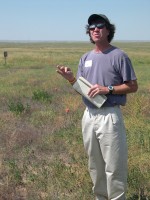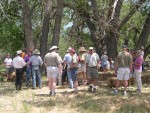It was a very busy review year for LTER sites...
In all seven sites (including the LTER Network Office) were reviewed by NSF review panels during 2005. Each LTER project is funded independently for six years at a time. An exception occurs if renewal proposals are recommended for probation or decline.
In this case, the site is placed on a two-year probation and must come back to the next renewal panel with a new, full proposal for continued funding over the remaining period of four years. If the second proposal is also recommended for decline, the site is discontinued. The current 26 sites are divided into three cohorts. Renewal panels are held in even years and mid-term; on-site reviews are held in odd years—thus, 2005 was an on-site review year.
Due to this structure, seven to 11 proposals are considered by each renewal panel, and the same range of sites is visited in the alternate years. Members for new site panels, renewal panels, and mid-term site review teams are nominated by all the programs in NSF that contribute to science funding at the sites under review. Renewal panels usually have about 12 members, while mid-term review teams have five; both panels and site review teams have minority membership by (unconflicted) LTER participants.
The LTER Program Officer at NSF makes the final assignments and organizes the review process, including the invitation of renewal proposals. All relevant Program Officers in NSF are invited to participate in the running of the panels and to attend site reviews as observers, as well as to provide input to the construction of the review/award/decline letters. Currently eight jackets are held outside the Division of Environmental Biology (DEB) (five in the Biological Oceanography Program, two in the Office of Polar Programs, and one in the Division of Biological Infrastructure).
Michelle Kelleher, Science Assistant, BIO/DEB, NSF

 Enlarge this image
Enlarge this image
